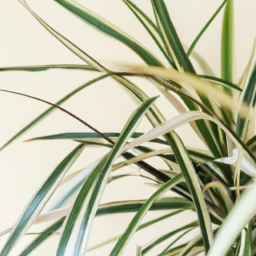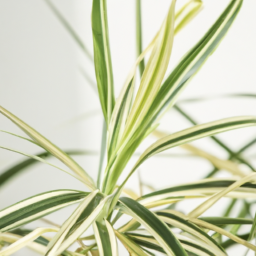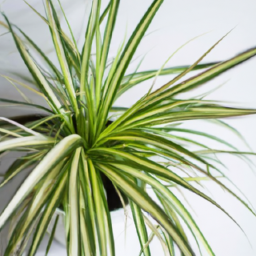
Spider plants are a popular choice for indoor plant enthusiasts due to their easy care and striking appearance. In this blog post, we will explore the different types of spider plants available, each with their own unique characteristics and growing requirements. Whether you’re a seasoned plant parent or just starting out, there’s a spider plant variety out there for everyone. Let’s dive in and discover the wonderful world of types of spider plants!
Different Varieties of Spider Plants
Variegated Spider Plants
Variegated spider plants are one of the most popular types of spider plants due to their unique and striking appearance. These plants have leaves that are green with white or cream-colored stripes running through them. The variegation adds a beautiful contrast to the plant and can brighten up any room. Variegated spider plants are relatively easy to care for and can thrive in a variety of conditions.
When caring for variegated spider plants, it is important to place them in indirect sunlight to prevent the leaves from getting sunburned. These plants prefer well-draining soil and should be watered when the top inch of soil feels dry to the touch. Variegated spider plants are also known for producing small white flowers, which can add an extra touch of beauty to the plant.
If you are looking for a visually stunning plant that is easy to care for, consider adding a variegated spider plant to your collection. With proper care, these plants can thrive and bring a pop of color to any space.
Green Spider Plants
Green spider plants, also known as Chlorophytum comosum, are another popular variety of spider plants that are loved for their lush green foliage. These plants have long, arching leaves that can reach up to 12 inches in length. Green spider plants are known for their air-purifying properties, making them a great addition to any indoor space.
When caring for green spider plants, it is important to place them in bright, indirect sunlight. These plants prefer well-draining soil and should be watered when the top inch of soil feels dry to the touch. Green spider plants are relatively low-maintenance and can thrive in a variety of conditions, making them perfect for beginner plant enthusiasts.
If you are looking for a hardy plant that can help improve the air quality in your home, consider adding a green spider plant to your collection. With proper care, these plants can thrive and bring a sense of calm to any space.
Baby Spider Plants
Baby spider plants, also known as spiderettes, are small offshoots that grow from the main plant and can be propagated to create new plants. These tiny plants are perfect for adding a touch of green to small spaces or for sharing with friends and family. Baby spider plants are relatively easy to care for and can thrive in a variety of conditions.
When caring for baby spider plants, it is important to place them in bright, indirect sunlight. These plants prefer well-draining soil and should be watered when the top inch of soil feels dry to the touch. Baby spider plants can be propagated by placing the offshoots in water until roots develop, then transferring them to soil to continue growing.
If you are looking to expand your plant collection or share the joy of gardening with others, consider propagating baby spider plants. With proper care, these tiny plants can thrive and bring a sense of happiness to any space.

Characteristics of Common Spider Plant Types
Variegated Spider Plants
Variegated spider plants are one of the most popular types of spider plants due to their striking appearance. These plants feature leaves that are green with white or cream-colored stripes running down the center. The variegation in the leaves adds a unique touch to any indoor space and can brighten up a room with its vibrant colors.
One of the key characteristics of variegated spider plants is their ability to thrive in a variety of lighting conditions. They can tolerate both bright, indirect light as well as low light, making them a versatile choice for indoor plant enthusiasts. These plants are also known for their air-purifying qualities, making them a great addition to any home or office environment.
In terms of care, variegated spider plants require regular watering to keep their soil moist but not waterlogged. They also benefit from occasional fertilization during the growing season to promote healthy growth. Overall, variegated spider plants are a low-maintenance option for those looking to add a touch of greenery to their indoor space.
Green Spider Plants
Green spider plants, also known as Chlorophytum comosum, are another common type of spider plant that is popular among plant enthusiasts. These plants feature solid green leaves that are long and slender, giving them a graceful and elegant appearance. Green spider plants are known for their ability to produce small white flowers, adding a delicate touch to their overall look.
One of the key characteristics of green spider plants is their resilience and adaptability. These plants can tolerate a wide range of lighting conditions, from bright, indirect light to low light, making them an ideal choice for indoor environments with varying light levels. Green spider plants are also known for their air-purifying qualities, helping to improve air quality in any space.
When it comes to care, green spider plants require regular watering to keep their soil moist but not waterlogged. They also benefit from occasional fertilization during the growing season to promote healthy growth. With proper care and maintenance, green spider plants can thrive and add a touch of natural beauty to any indoor space.
Curly Spider Plants
Curly spider plants, also known as Chlorophytum comosum ‘Bonnie,’ are a unique and eye-catching variety of spider plant. These plants feature leaves that are curly and twisted, giving them a distinctive appearance that sets them apart from other types of spider plants. The curly leaves add a touch of whimsy and charm to any indoor space, making them a popular choice among plant enthusiasts.
One of the key characteristics of curly spider plants is their ability to thrive in a variety of lighting conditions. They can tolerate both bright, indirect light as well as low light, making them a versatile option for indoor environments with varying light levels. Curly spider plants are also known for their air-purifying qualities, helping to improve air quality in any space.
In terms of care, curly spider plants require regular watering to keep their soil moist but not waterlogged. They also benefit from occasional fertilization during the growing season to promote healthy growth. With proper care and maintenance, curly spider plants can thrive and add a touch of elegance to any indoor space.

Care Tips for Various Types of Spider Plants
Introduction
Spider plants are popular houseplants known for their long, slender leaves that cascade down like spider legs. There are several different types of spider plants, each with its own unique characteristics and care requirements. In this guide, we will explore the various types of spider plants and provide care tips for each.
Variegated Spider Plants
Variegated spider plants are characterized by their green and white striped leaves, adding a pop of color to any indoor space. These plants are relatively easy to care for, requiring bright, indirect light and well-draining soil. Make sure to water them regularly, allowing the top inch of soil to dry out between waterings. Variegated spider plants can benefit from occasional misting to increase humidity levels.
Propagation is a common practice with variegated spider plants, as they produce baby spider plantlets that can be easily rooted in water or soil. To encourage growth, fertilize your variegated spider plant every 2-4 weeks during the growing season with a balanced houseplant fertilizer. Keep an eye out for pests such as spider mites, which can be treated with insecticidal soap.
Overall, variegated spider plants are a great choice for beginners looking to add a touch of greenery to their home.
Curly Spider Plants
Curly spider plants, also known as Bonnie spider plants, have unique leaves that curl and twist, giving them a whimsical appearance. These plants thrive in bright, indirect light but can tolerate lower light conditions. Keep the soil consistently moist but not waterlogged, as overwatering can lead to root rot.
Propagation of curly spider plants is similar to variegated spider plants, with baby spider plantlets forming on long stems. Prune these plantlets to encourage a bushier growth habit. Fertilize your curly spider plant every 4-6 weeks during the growing season with a diluted houseplant fertilizer.
Curly spider plants are relatively pest-resistant but may attract spider mites in dry conditions. Increase humidity levels by misting the plant or placing a humidifier nearby to prevent pest infestations.
Green Spider Plants
Green spider plants, also known as Chlorophytum comosum, are the classic variety of spider plants with solid green leaves. These plants are incredibly versatile and can thrive in a wide range of light conditions, from bright, indirect light to low light. Water green spider plants when the top inch of soil is dry, and be sure to provide adequate drainage to prevent waterlogging.
Propagation of green spider plants is straightforward, with baby spider plantlets forming on long stems. These plantlets can be rooted in water or soil to create new plants. Fertilize your green spider plant every 4-6 weeks during the growing season with a balanced houseplant fertilizer.
Green spider plants are relatively low-maintenance and can tolerate neglect, making them a great choice for busy plant parents. Keep an eye out for common pests such as spider mites and mealybugs, which can be treated with insecticidal soap.
In conclusion, spider plants come in a variety of types, each with its own unique characteristics and care requirements. By following these care tips, you can ensure that your spider plants thrive and add beauty to your indoor space.
Let’s recap
Spider plants are popular houseplants known for their long, slender leaves that resemble spider legs. There are several different types of spider plants, each with its own unique characteristics. The most common variety is the Chlorophytum comosum, also known as the traditional spider plant, which has green and white striped leaves that cascade gracefully from the plant.
Another popular type of spider plant is the Chlorophytum comosum ‘Bonnie’, which has solid green leaves and is more compact in size compared to the traditional variety. There is also the Chlorophytum comosum ‘Vittatum’, which has narrower leaves with white margins, giving it a more delicate appearance. Lastly, the Chlorophytum comosum ‘Variegatum’ features green leaves with white stripes and is known for its striking variegated foliage. Each type of spider plant is easy to care for and adds a touch of natural beauty to any indoor space. Whether you prefer the classic look of the traditional variety or the unique characteristics of the other types, there is a spider plant to suit every plant lover’s taste.
Frequently Asked Questions (FAQ):
Q1. What are the different types of spider plants?
A1. Spider plants come in various types, including the classic green spider plant (Chlorophytum comosum), the variegated spider plant with white stripes on the leaves, and the curly spider plant with uniquely twisted foliage.
Q2. How do I distinguish between the different types of spider plants?
A2. You can distinguish between the types of spider plants based on their leaf coloration and shape. The classic green spider plant has solid green leaves, while the variegated spider plant has white stripes. The curly spider plant can be identified by its twisted foliage.
Q3. Do different types of spider plants require different care?
A3. While all spider plants have similar care requirements, such as bright indirect light and well-draining soil, some variations may have specific needs. For example, variegated spider plants may require slightly more sunlight to maintain their white stripes.
Q4. Can different types of spider plants be grown together in the same pot?
A4. Yes, different types of spider plants can be grown together in the same pot without any issues. Mixing different varieties can create a visually appealing display of varying leaf colors and shapes.
Q5. Where can I find different types of spider plants to purchase?
A5. Different types of spider plants can be found at local nurseries, garden centers, or online plant shops. You can also consider trading with other plant enthusiasts or attending plant swaps to expand your collection.
Dr. Olivia Green is a botanist with over two decades of experience in indoor plant cultivation. She holds a Ph.D. in Plant Biology and has dedicated her career to researching plant behavior in controlled environments. Dr. Green is passionate about helping plant enthusiasts master the art of indoor gardening through her extensive knowledge and practical insights.


